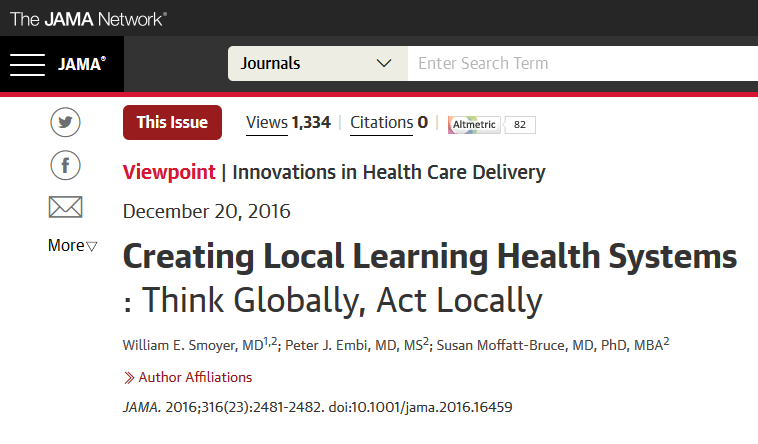
“Transforming the delivery of health care to maximize value, by measurably improving clinical outcomes while simultaneously reducing costs, is fundamental to reforming health care. Achieving such a goal requires fundamental changes to health care delivery, through so-called clinical transformation efforts that better align people, processes, and technology. As such efforts continue to gain momentum, they increasingly demonstrate the importance of weaving continuous and systematic evidence-generating medicine activities into routine practice. This model creates a continuous cycle of systematic care improvement by coupling evidence generation with evidence application to health care that embodies and enables the goals of the learning health system (LHS).”
This excerpt is drawn from a Viewpoint article by William E. Smoyer, MD et al in the December 20, 2016 edition of the Journal of the American Medical Association entitled “Creating Local Learning Health Systems — Think Globally, Act Locally” (http://jamanetwork.com/journals/jama/article-abstract/2593578) that describes a pediatrics-focused LHS pilot program. The program, called Learn From Every Patient (LFEP), was staffed by a clinical leader committed to systematic care improvement and a team of clinical, administrative and information technology / informatics stakeholders; and it anticipated these benefits to the healthcare provider organization and its patients:
- evidence- and expert opinion-based standardized care,
- systematic discrete research data collection focused on care improvement,
- clinical and translational research publication opportunities, and
- opportunities to participate in systematic patient care improvement.
However, to realize these benefits “… participation in the pilot program also required notable changes in work culture and routine workflows … [including] altered clinical practices and EHR [electronic health record] documentation processes for physicians and nurses (ie, robust discrete data entry vs. free text entry) as well as altered interactions between the hospital and research informatics teams (ie, integrated clinical research data queries).” Clearly the implementation of such a program is non-trivial, not only because of the scope and depth of change required but also because of the policy/practice/procedure revisions to be designed, documented and learned by already cognitively overburdened staff.
The implicated healthcare provider administrative, clinical and ancillary subject matter experts (SMEs) should have available to them an information technology (IT) solution conforming to the Cloud Healthcare Appliance Real-Time Solution as a Service (CHARTSaaS) reference architecture (RA), as described in these presentations:
Using a CHARTSaaS RA-compliant IT solution, the SMEs could build LHS applications a.k.a. “apps” to effect the required changes and create the required capabilities directly with little or no IT staff assistance and no additional cognitive overload to accommodate during operation. “Apps” built using a CHARTSaaS RA-compliant IT solution, the components of which now are available as commercial off the shelf (COTS) products and services from several selected independent software vendors (ISVs) and cloud service providers (CSPs), will provide with minimal cost and complexity the IT-enabled cognitive support required to realize LHS benefits in a secure, scalable and sharable manner.
Please contact me, Pete Melrose, at 001-612-201-2301 or jpetermelrose@gmail.com, to discuss and decide re the implementation of a CHARTSaaS RA-compliant solution by your healthcare provider organization to relieve cognitive overload, which is arguably the root cause of medical mistakes, currently the third leading cause of patient deaths (re http://www.bmj.com/content/353/bmj.i2139).